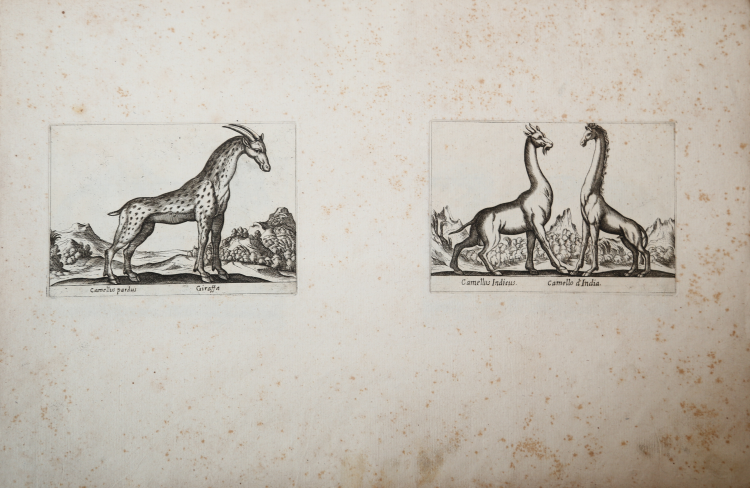



| Reference: | s34507 |
| Author | Antonio TEMPESTA |
| Year: | 1620 ca. |
| Measures: | 415 x 280 mm |


| Reference: | s34507 |
| Author | Antonio TEMPESTA |
| Year: | 1620 ca. |
| Measures: | 415 x 280 mm |
Due incisioni impresse su un foglio di carta vergata, disegnate ed incise, all'acquaforte e al bulino, da Antonio Tempesta.
Le due immagini furono pubblicate nella serie Nuova raccolta de li Animali più curiosi del mondo […], di Antonio Tempesta, opera che conobbe numerose edizioni dopo la prima del 1620, edita da Giandomenico de Rossi.
L'opera è un bestiario, privo di testo, che comprende in buona parte la prima e ampia iconografia zoologica, ma anche animali fantastici della tradizione mitologica, come il grifone o il satiro marino.
Le immagini dell'opera, nella prima edizione 222, erano distribuite su 111 fogli oblunghi, con due lastre stampate per ciascun foglio. Ciascuna immagine ha una didascalia con il nome dell'animale raffigurato in latino e in italiano.
Foglio in ottimo stato di conservazione con margini originali.
Dimensioni della singola incisone: 137x97.
Antonio TEMPESTA (Firenze 1555 – Roma 1630)
|
Italian painter, draughtsman and printmaker. Enrolled at the Accademia del Disegno in Florence on 8 December 1576, he was a pupil of Santi di Tito, then of Joannes Stradanus, with whom he worked under Giorgio Vasari on the interior decoration of the Palazzo Vecchio in Florence. He then went to Rome, where he again had links with artists from the Netherlands. He and Matthijs Bril were commissioned by Pope Gregory XIII to paint the Transfer of the Relics of St Gregory of Nazianzus (1572) and other religious scenes in the loggias on the third floor of the Vatican Palace. In Tempesta’s frescoes in the Palazzina Gambara at the Villa Lante in Bagnaia (1578–9), the hunting and fishing scenes, sweeping landscapes and urban backdrops again reveal the influence of Netherlandish art. From 1579 to 1583 Tempesta participated in the decoration of the Palazzo Farnese in Caprarola, notably of the Scala Regia. He is also known to have collaborated on the frescoes in the Villa d’Este at Tivoli.
|
Antonio TEMPESTA (Firenze 1555 – Roma 1630)
|
Italian painter, draughtsman and printmaker. Enrolled at the Accademia del Disegno in Florence on 8 December 1576, he was a pupil of Santi di Tito, then of Joannes Stradanus, with whom he worked under Giorgio Vasari on the interior decoration of the Palazzo Vecchio in Florence. He then went to Rome, where he again had links with artists from the Netherlands. He and Matthijs Bril were commissioned by Pope Gregory XIII to paint the Transfer of the Relics of St Gregory of Nazianzus (1572) and other religious scenes in the loggias on the third floor of the Vatican Palace. In Tempesta’s frescoes in the Palazzina Gambara at the Villa Lante in Bagnaia (1578–9), the hunting and fishing scenes, sweeping landscapes and urban backdrops again reveal the influence of Netherlandish art. From 1579 to 1583 Tempesta participated in the decoration of the Palazzo Farnese in Caprarola, notably of the Scala Regia. He is also known to have collaborated on the frescoes in the Villa d’Este at Tivoli.
|